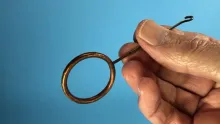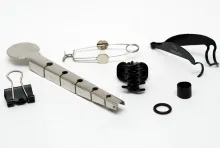Siberian Ramil Yamaliev makes a lot of things on his 3D printer - from fly reels to lamps. And then this brilliant dubbing brush twister.
I have written about the tools made by Ramil Yamaliev before, and Ramil has been kind enough to let me have a peek into his world of weird and wonderful 3D tools, namely in the form of his LED based fly lamps, which he calls Flies Photo Gadgets. Ramil is based in Krasnoyarsk in Siberia, but sells and ships his products internationally through the online shop YR3D.
A while back Ramil sent me a dubbing brush twister that he has designed and produces. Like the rest of his products, it’s 3D printed and bears the hallmarks of this kind of production in the form of being plastic and having a fairly rough finish, but still being both solid and functional.
The idea behind the tool is to make a “platform” on which you can lay down the materials you want to turn into a tool and arrange them neatly before twisting them. One thread lays in a groove under the materials and you place the other on top and then use an ordinary dubbing twister to spin the thread. This particular tool is special because it’s constructed so that it sits om your vise and can be turned into position when used, and away when you don’t need it.
|
|
|
|
Adjustable
It’s adjustable so that you can place the tip of the platform exactly where the dubbing loop is located on the hook, and it gives you great control over the whole process, which can be done with ease since everything rests, and you don’t have loose threads, clamps of anything else that you have to hold and guide precisely in place.
This open up for using all kinds of materials for your brushes, from ordinary dubbing forming a rope to long fibers of varying materials as well as natural hairs, forming large and dense brushes.
It’s a much easier process than doing it by hand, maybe using wax to keep things in place, or using various types of bulldog or magic clamps. The clamps work nicely, but positioning your materials is somewhat a test of your dexterity, and oftentimes you don’t get them to sit perfectly, and have to trim the butts in order to get a decent result.
With this tool, you simply lay down the material on top of the bottom thread and arrange them exactly where you want them before catching them securely with top thread and spinning them.
Other tools can do the same. I have been using Czech Jam Siman’s dubbing block for many years – both the old and the new model – and Italian Stonfo also has a tool very similar to this one, but quite a bit more complex, and not least larger. Both of these are significantly more expensive than Ramilev’s 22-25 dollar product Add the 11 dollar for shipping, and you still have a very inexpensive tool.
Facts and contact
Fly tying Dubbing Brush Tool
US$ 22.- + $11.- shipping.
Other products mentioned:
Stonfo Dubbing Brush Device
Typically priced at 55 Euros.
Siman Turbo Spinning Block
Priced at 69 Euros.
Two versions
My version of Ramil’s tool comes with two flat platforms – a short and a long one – well suited for longer fiber laying perpendicular to the thread, potentially creating some pretty large brushes. There is also a version, which comes with one flat platform and one grooved one, the latter being well suited for loose dubbing, which is going to be twisted into a rope. I had no problems using the flat platforms for loose dubbing, but the grooved version may give a little more control.
It’s not a luxury tool in any way. As already mentioned, the 3D printed parts are pretty rough, but it works like a charm, and does exactly what it’s supposed to: give you much better control over the dubbing brush process, and it does so right at your vise.
Should you want to make loose brushes using copper or steel wire, or soft brushes using three tying threads, that is no problem. You can use the tool as a “loose” tool, still mounted on your vise, but independently of tying a fly, and simply start a production, making several brushes, ready to be used in your tying.
As I said: a brilliant and inexpensive tool.
a brilliant and inexpensive tool
- Log in to post comments















Thank you Martin!!!
Thank you Martin!!!